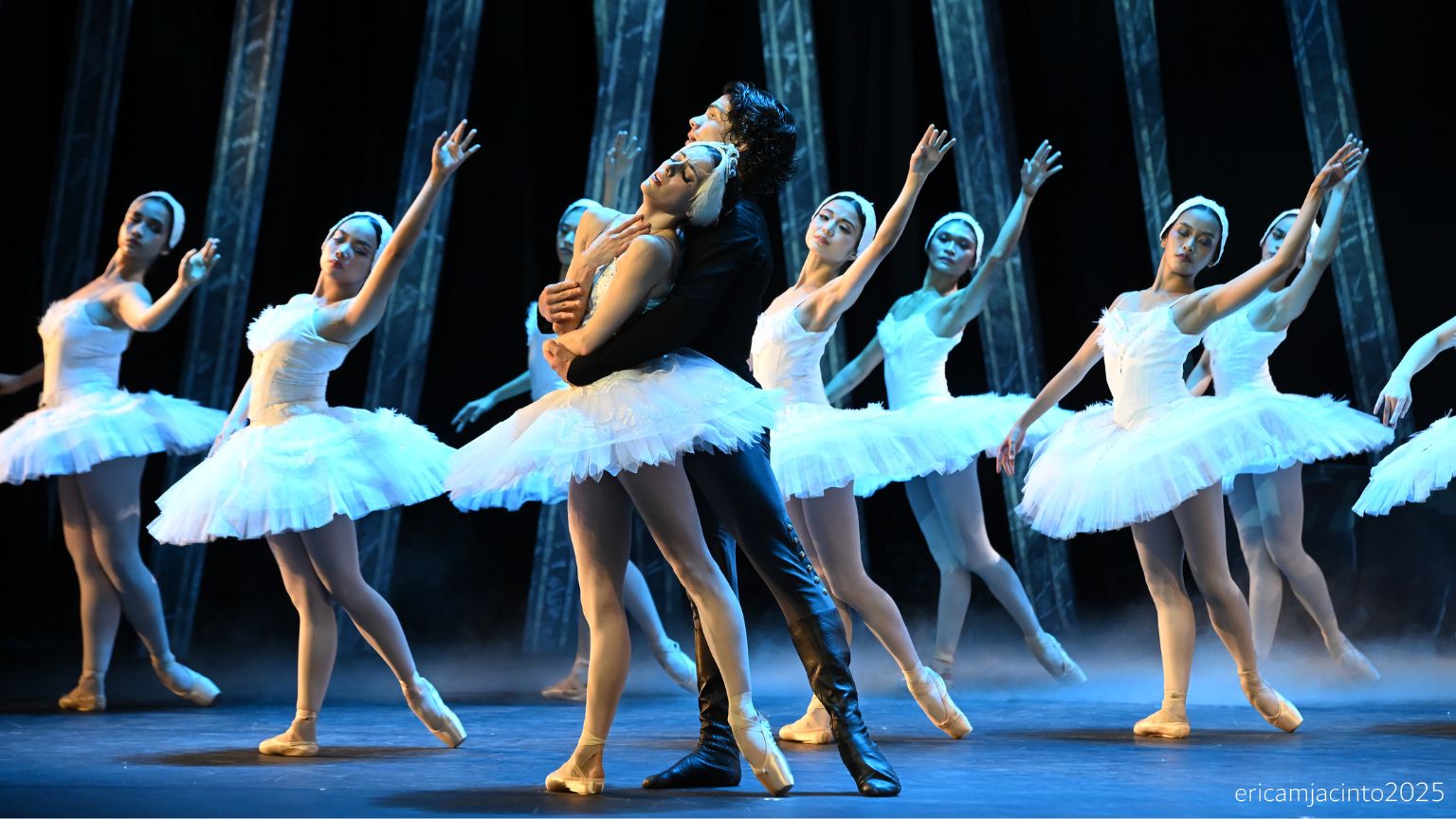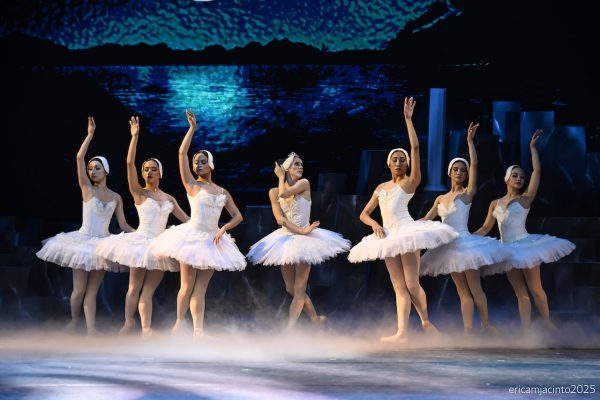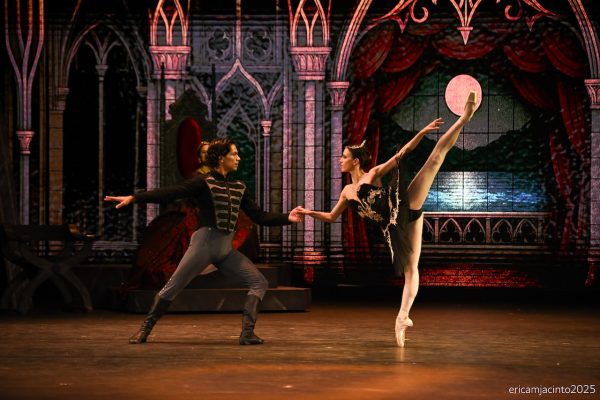
REVIEW: Ballet Manila’s ‘Swan Lake’ Soars on the Strength of Its Ensemble
In an impressive staging at the Aliw Theater, Ballet Manila’s Swan Lake delivered a performance where the ultimate victory belonged not necessarily to the principal dancers, but to the ensemble.
“Swan Lake” follows Prince Siegfried, who falls for Odette, a princess cursed by the sorcerer Rothbart to live as a swan by day. At a royal ball, Rothbart’s daughter Odile deceives Siegfried into breaking his vow. Realizing the truth, Siegfried returns to Odette at the lake, where the lovers choose death over separation, breaking the curse. Tchaikovsky’s score drives this dark tale of love, illusion and fate.
Unlike other traditional productions, the corps de ballet holds a pivotal status. “Swan Lake” elevated them to the central narrative. The female corps become embodiments of the swan maidens. Their movements convey the curse and tragedy that define the famous “White Acts” (Acts II and IV) held in their domain, the enchanted lake.
Ballet Manila (BM) broke from the strict physical uniformity that defines many international troupes. The ensemble was composed of various body types, a choice that, while perhaps challenging the seamless illusion for some purists, lent a raw and convincing humanity to the flock. While more rigorous body conditioning might have refined certain lines, the dancers made up for it with a focused, unified commitment to the story.
The choreography, drawn from the 1895 revival by Lev Ivanov, is known for its demanding precision in style. BM’s corps lived up to it as they floated across the stage with a flawless unison to create the illusion of swans. The synchronized undulating “swan arms,” which rippled through the ranks, along with the tilting of their heads and shoulders to evoke the bird-like movements was breathtaking. Without missing a beat, these dancers seamlessly traversed through the geometric formations representing the swans swimming on the lake, taking flight, and protecting their queen, Odette. The corps de ballet’s unison arabesque jumps rose with commanding precision, each dancer reaching skyward with fully stretched feet.
Through their collective movement, the corps de ballet expressed a range of emotions—from the deep sorrow of their fate and fear of the Prince’s arrival to their fierce loyalty to Odette. The swan formations reached their peak in a striking contrast: the Big Swans (Rissa Camaclang, Stephanie Santiago, Francesca Raypon, Shamira Drapete) delivered sweeping arm movements, hovering balances and soaring jumps, followed by the rapid footwork and synchronized head tilts of the Little Swans (Jessica Pearl Dames, Shaira Comeros, Jessa Balote, Nanami Hasegawa), who breezed through a fiendishly difficult variation.

L-R: Nanami Hasegawa, Jessa Balote, Rissa Camaclang, Katherine Barkman, Stephanie Santiago, Shaira Comeros, Jessica Pearl Dames; Photo Credit: Erica Feliz Marquez-Jacinto
The male corps de ballet proved equally seasoned. In Act I at the Prince’s coming-of-age garden party, their waltz was marked by strong, unified execution of multiple turns, supported pirouettes, lifts, and suave over-the-shoulder lifts.
In the Pas de Trois, Jessica Pearl Dames impressed with her quick jumps, sharp directional turns, and fast bourrées, while Shaira Comeros brought stylistic clarity, executing tricky pirouettes and sustained balances with poise. Both dancers demonstrated precise musicality, hitting every accent with confidence. Joshua Enciso delivered clear aerial turns and swift footwork, though his big jumps felt slightly rushed, lacking full expressive breadth.
As the Jester, Rafael Perez wowed the audience with soaring circuit jumps, explosive barrel turns, and tight multiple pirouettes. The performance would have been even more engaging had his facial expressions and gestures been more animated.
While the seasoned corps de ballet enthralled with their polished unison and maturity, the Act II ballroom scene fell flat. The character dances, particularly the Hungarian and Polish, lacked energy and precision, undermining their traditional sharpness. The Spanish dance gained some flair through Odile’s commanding presence. The Neapolitan was well-executed by Romeo Peralta and Sayaka Ishibashi, but the choreography did not match their technical skill, making the dance less exciting than expected.
The most anticipated moments were the duets between Prince Siegfried and his two loves: Odette, the swan queen, and Odile, her dark double. Katherine Barkman, first soloist with San Francisco Ballet (SFB), returned to a role she first performed in 2017—a milestone shaped by Ballet Manila artistic director Lisa Macuja Elizalde, who gave the dual roles as a rite of passage and helped build the physical and emotional endurance.
Later, at The Washington Ballet, then–artistic director Julie Kent honed the finer details of Barkman’s interpretation—shaping the delicate expressiveness of the neck and face, refining the softness of Odette’s arms, and encouraging her to let the music breathe through her rather than chasing technical precision. Barkman has grown into an interpreter who listens deeply—to the score, to the silence between notes, to the emotional logic of movement.
Her arabesques cut across the stage like a sliver of light. The closing quivers of the foot and the end of the pas de deux were so sharp that their vibrations were visible even from the furthest rows of the theater.
As Odile, she was alluring, sly, and steely. The traditional 32 fouettés—those whipping turns that serve as ballet’s ultimate endurance test—were dispatched with flair. Both Barkman and her alternate, Abigail Oliveiro, went further, launching into double fouettés early in the sequence.

Katherine Barkman as Odile and Esteban Hernandez as Prince Siegfried; Photo Credit: Erica Feliz Marquez-Jacinto
Now under the guidance of SFB artistic director Tamara Rojo, Barkman has evolved into a dancer of daring. One of her pirouettes boldly mimicked the men’s style, her balances elongated to improbable lengths, her jumps infused with more elevation. Yet it was in her grounded and calculated walk as Odile that she revealed the depth of her artistry, suggesting not only the character’s duplicity but also the inescapable pull of Rothbart’s shadow.
Though cast in a largely supportive role, Esteban Hernandez, SFB principal dancer with San Francisco Ballet, brought authority and refined presence to Prince Siegfried. As Barkman’s frequent partner, he matched her with instinctive timing and restraint, amplifying the emotional arc of both Odette and Odile. Their familiarity lent a natural ease to the partnering—seamless, and emotionally aligned. Hernandez’s mime was purposeful, free of excess, and his solos struck a balance between technique and artistry. Rather than chasing velocity, he ended turns in deliberate stillness, holding final poses just long enough to let them register. It was not a display of virtuosity for its own sake, but of control, musicality, and quiet command.
Alternate cast members Abigail Oliveiro and San Francisco Ballet soloist Nathaniel Remez delivered a competent performance—understandable given that it was their first time dancing together. Oliveiro brought a mysterious, almost otherworldly quality to Odette, while her Odile was notably alluring. Though she met the technical demands of Odile’s role, there were moments when momentum flagged during the fouettés and her lines slackened in the more intricate turns. Yet these imperfections revealed a more human side to her Odile.
At 6’2”, Remez was striking as the Prince, moving with elegance and grace. Though his solo featured impressive height, it sometimes lacked the solid, grounded quality that gives the movement weight and presence.
Rothbart’s choreography was limited to jumps, flapping wings, and occasional lifts, leaving much of Mark Sumaylo’s talent and maturity untapped. The staging failed to convey his control over the swans or the intense struggle between him and the Prince for Odette’s fate. In the end, the role felt less like a force of menace and more like irritating décor.
Above all, it was Elizalde’s staging that grounded Swan Lake as the real deal, then she stole two scenes with her commanding turn as the Queen Mother.
Tickets: Evening shows- P2,060 (Center), P1,030 (Sides); Matinee shows- P1,442 (Center), P721 (Sides)
Show Dates: May 30 to June 1
Venue: Aliw Theater
Running Time: 2 hours and 30 minutes (inclusive of a 20-minute intermission)
Company: Ballet Manila
Creatives: Lisa Macuja Elizalde (artistic director and overall direction, choreography), Sergev Vikulov (choreography), Eileen Lopez restager and ballet mistress), Lev Ivanov and Marius Pepita (choreography), Peter Tchaikovsky (music), Gerardo Francisco Jr. (ballet master), Mark Daniel Dalacat (scene design), House of Michael Miguel (costume design), Carlo Reyes (lighting design), Joyce Garcia (visual projection design), Deidrich Tanteco (associate design)
Featured Cast: Odette/Odile: Katherine Barkman/ Abigail Oliveiro; Prince Siegfried: Esteban Hernandez/ Nathaniel Remez; Von Rothbart: Mark Sumaylo; Big Swans: Rissa Camaclang, Stephanie Santiago, Francesca Raypon, Shamira Drapete; Little Swans/Cygnets: Shaira Comeros, Jessica Pearl Dames, Nanami Hasegawa, Jessa Balote; Jester: Rafael Perez/ Benedict Sabularse; Pas de Trois: Shaira Comeros, Joshua Enciso, Jessica Pearl Dames/ Nanami Hasegawa, Noah Esplana, Jessa Balote


Comments